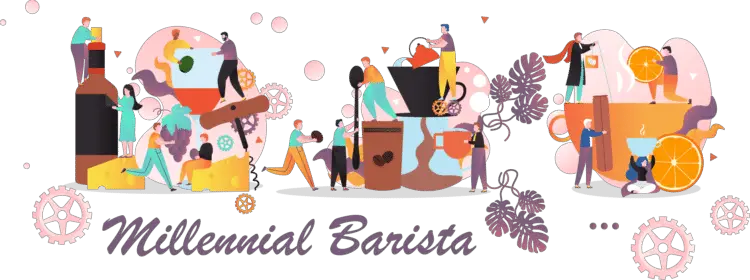Most of us can’t even think of starting off our hectic days without a cup of coffee. We rely on that caffeine to pep us up and get us going so we can face the daily grind. Nestled into the cupholder of our car while we sit on the highway wondering when they’ll ever finish this construction work (spoiler alert: never!), at our workstations while we toil away, coffee is ‘Old Reliable’ because of that blessed caffeine in every cup.
But exactly how much caffeine is in your cup?
Perhaps you’ve pondered that before while sipping it. And if not, now you’re going to, aren’t you?
Fortunately, it’s not too difficult to calculate the caffeine content in your coffee cup. All you need to do is weigh your dry coffee in grams. You take that number and multiply it by 0.008. So, basically, every 10 grams of dry coffee, contain 80mg of caffeine.
We’ve included a handy caffeine list to help you with that along with the strongest coffee brands just in case you want to step up your caffeine intake or even tone it down slightly while still enjoying the sweet morning nectar that is coffee.
Of course, there’s a little more to it than some simple math. Keep reading and you’ll find out more about the caffeine content in your coffee and how to amplify your morning buzz!
What Factors Affect Caffeine Content?
While that basic equation above can help you get a decent handle on things, the caffeine content in your coffee also depends on a few other factors. Let’s break those down, shall we?
– The coffee beans themselves
There are many different kinds of coffee beans out there and they all contain varying amounts of caffeine. The most common coffee on the planet is Arabica. As much as 70% of the coffee in the entire world is from Arabica beans. These beans don’t have as much caffeine as other coffee beans. Robusta has twice as much the caffeine as Arabica which is why you should try those beans on for size, if a higher caffeine content is your biggest coffee concern.
– Then there’s the roast
Once you decide on the type of beans you want, you have to make another decision…which roast? You might think that lighter roasts have less caffeine, but you’d be wrong. They have more caffeine than the darker roasts even though darker roasts have a much deeper, more complex flavor.
During the roasting process, the coffee beans lose water and expand. And the longer you roast it, the more caffeine it loses per scoop. So, light and medium roasts will have more caffeine than their darker counterparts. It’s a trade-off only you can decide. If you need more caffeine, go with a lighter roast. If you want a stronger flavor and care not about the caffeine, take on the darker roasts.
– Coffee types
As a coffee lover, you likely know there are different types of coffee to choose from too. The content of caffeine varies greatly between a cup of coffee that is brewed regularly, espresso, and instant. And obviously, all of these have more caffeine than decaf coffee.
– Water temperature
The temperature of your water affects the taste of your coffee as well as how much caffeine gets into your cup. When you use hot water that ranges from 195°F to 205°F (and please note, you should never go over this temperature!), you will extract more caffeine from your coffee. Those cold brew coffees then have much less caffeine than their hotter counterparts.
– Size of your cup
Do you have a favorite coffee mug? We all do! But perhaps on weekdays, you leave it on the shelf in favor of a thermos you can take along to work. That ‘cup’ you use can be anywhere from one to 24 ounces in size. Obviously, the more coffee you can fit into your drinking vessel, the more caffeine you’ll have.
How Much Caffeine is in a Cup of Coffee?
Now that we’ve covered all that, let’s find out how much caffeine is in your cup of coffee. To do so, we’re going to need to find out which type of coffee you drink. Read on to see how much caffeine you’re getting from your morning cup!
– Brewed coffee
- This is the most popular way coffee is made in the US as well as Europe!
- It involves pouring hot to boiling water over fresh ground coffee beans in a filter
- One cup at 8 ounces has between 70 to 140mg of caffeine
- That’s about 95mg on average!
– Espresso
- Espresso requires small amounts of hot water to be forced through finely-ground coffee beans
- It has more caffeine per volume though less per serving since espresso servings are smaller
- One shot is roughly 30 to 50ml with around 63mg of caffeine (According to the USDA 100 ml has 212mg of caffeine)
- Want more caffeine? Do a double shot to get around 125mg of caffeine!
– Espresso-based drinks
- These consist of those popular drinks you get at your favorite coffee house like lattes, macchiatos, cappuccinos, and Americanos
- They mix espresso shots with different types of milk in different amounts
- They have the same amount of caffeine as your regular espresso
- That means a single shot has about 63mg while a double has about 125mg of caffeine
– Instant coffee
- This kind of coffee takes brewed coffee and freeze-dries or spray-dries it
- The large pieces that this process creates are designed to dissolve into water
- You make it by mixing 1 or 2 teaspoons of instant coffee with hot water
- It has less caffeine than regular brewed coffee
- For one cup, you get around 96mg of caffeine
– Decaf
- Decaf still has caffeine in it
- The amount is much less than any other type of coffee
- You’ll get anywhere from zero to 7mg per cup
- On average, that’s 2,4mg of caffeine according to the USDA
- Some types of decaf may have even more caffeine than that though due to the type of coffee, cup size, and process for decaffeination
Are Commercial Brands More Caffeinated?
Do you treat yourself to a coffee on the go? If so, you might be getting more caffeine than you do when you brew at home depending on which brand you choose and the size of the coffee you buy.
The sizes of coffee available to buy at your favorite coffee shop are also much larger than most cups you’d choose at home. Some are a whopping 24 ounces which works out to about 3 to 5 of your regular-sized cups. No wonder you get such a buzz!
Read on to see if your favorite commercial brands are on our list!
– Starbucks
If you’ve never heard of Starbucks, you’ve likely been living in a cave. It’s one of the best-known coffee brands in the world and it has some of the most caffeinated coffees to boot.
- Short (8 oz): 180 mg
- Tall (12 oz): 260 mg
- Grande (16 oz): 330 mg
- Venti (20 oz): 415 mg
- One shot of espresso: 75 mg
- All small espresso-based drinks: 75 mg
- Larger-sized espresso drinks: 150 to 225 mg
- Decaf: 15 to 30 mg
In short, if you really need a caffeine boost, Starbucks is the place to be!
– McDonald’s
McDonald’s brand of coffee drinks, McCafe, also has worldwide reach. Despite this though, they don’t have a standard calculation for the caffeine content in their coffee. Estimates though have been computed for your convenience.
- Small (12 oz): 109 mg
- Medium (16 oz): 145 mg
- Large (21–24 oz): 180 mg
- Espresso: 71 mg
- Decaf: 8 to 14 mg
– Dunkin Donuts
If you’re a donut lover (and really, who isn’t?), you might cruise by your local Dunkin for a donut or two. Or a dozen and a box of munchkins for the office crew. And of course, you’re going to get a coffee to go with it.
- Small (10 oz): 215 mg
- Medium (16 oz): 302 mg
- Large (20 oz): 431 mg
- Extra-large (24 oz): 517 mg
- Espresso: 75 mg
- Espresso-based drinks: 75 mg
- Decaf: 53 to 128 mg
Side note: if for some reason you want a decaf coffee or are drinking decaf because you’re pregnant, it’s probably not a good idea to get one from your neighborhood Dunkin Donuts!
– Seattle’s Best
You’ll find this big coffee brand in its retail stores and can drive-thru for it too. You’ll even find it in fast food chains like Burger King and Subway.
- Brewed coffee (12 oz): 260 mg
- Latte (12 oz): 75 mg (classic and flavored varieties)
- Mocha (12 oz): 80 mg
- Espresso: 75 mg
6 ultra-caffeinated coffee brands
Even if you love coffee, it can get expensive to buy it every morning on your way to work. But when you brew at home, you don’t have to settle for bland beans. And you don’t even have to compromise your caffeine either.
There are some coffee brands out there that give you more caffeine than a regular cup, even when you’re using an ordinary drip machine. Among them, Death Wish Coffee has over 700 mg of caffeine in a regular-sized cup (more on that below).
This brand as well as the others we’ve got lined up for you below uses a blend of both Arabica and Robusta beans. That Robusta gives you the caffeine kick in the rear that you need to get moving every morning while the Arabica brings a wonderful flavor. The kind of flavor that got Jimmie his coffee compliments in Pulp Fiction, no doubt!
Check out these highly-rated high-caffeine coffees you can brew at home!
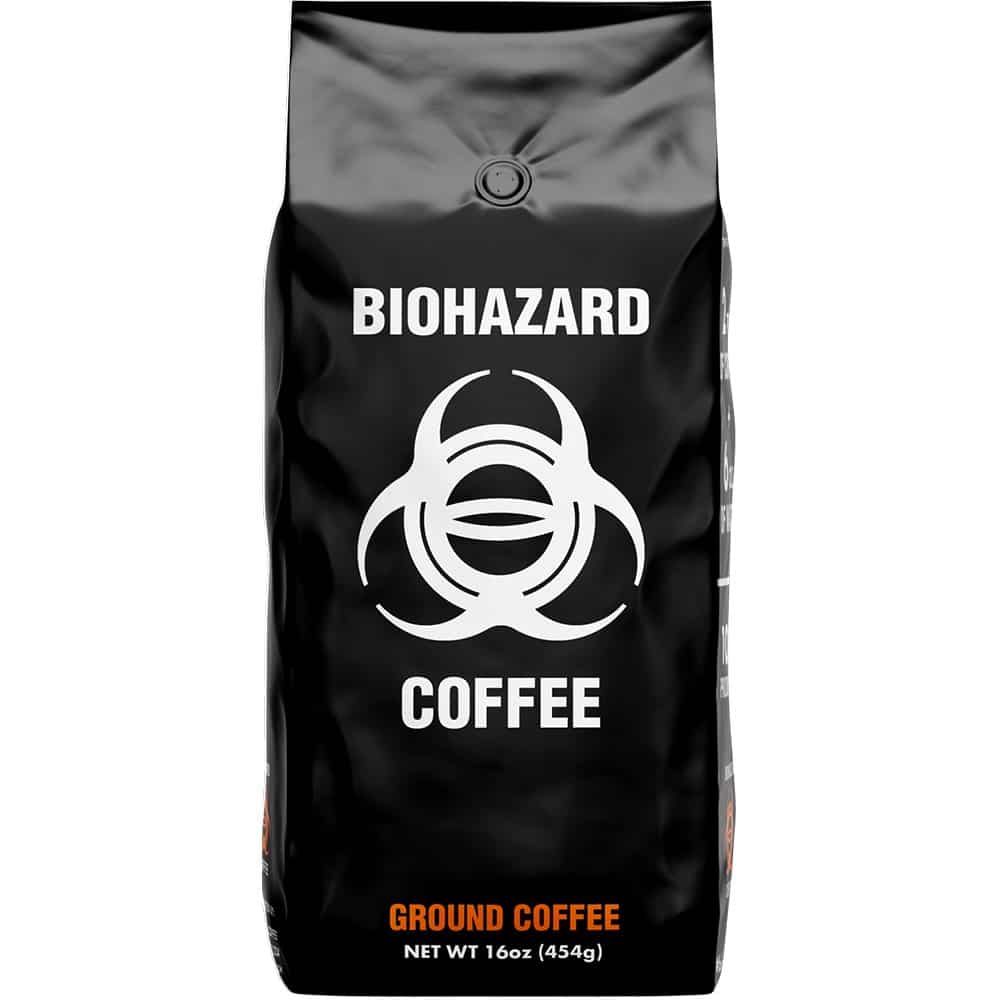
– Biohazard Coffee
It’s earthy with touches of cherry and hazelnut, but don’t let that hippie-feeling make you doubt the caffeine within. It delivers 928 mg per 12 ounces, which is even more than having three doubles of espresso. While that might sound great when you need to pull an all-nighter or “Baby Shark” was on replay in your brain all night preventing your sleep, it’s not recommended to consume more than 400 mg for most grownups. Generally, 600 mg is the limit before you hit a caffeine overdose.
If you drank just half of that though, you’d get a caffeine jolt over 600 mg so do watch out before you wind up like Frye on that one episode of Futurama with all the coffee.
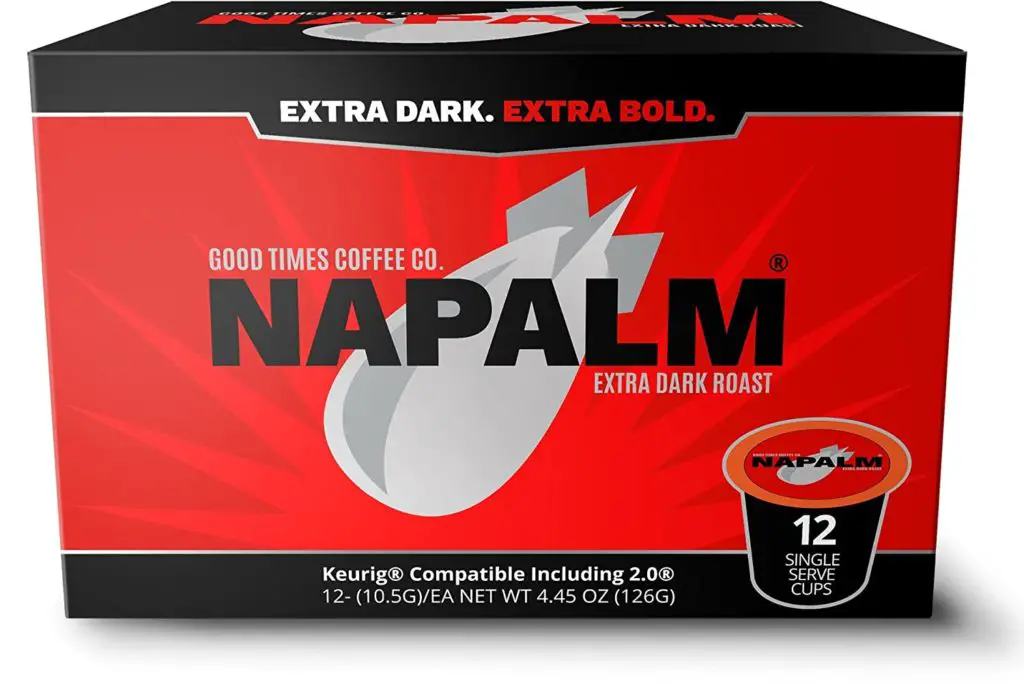
– Napalm Extra Bold Coffee
This brand features 100% Arabica beans. Founded by Good Times Coffee Co., they double the caffeine in a regular cup. That’s plenty to rev your engine without going over the top unless you drink the whole pot by your lonesome.
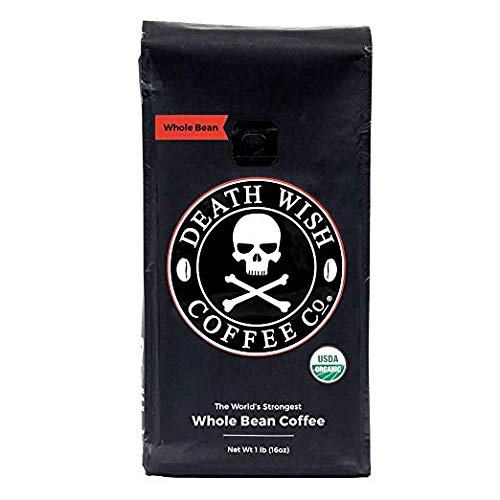
– Death Wish Coffee
We briefly mentioned the Death Wish Coffee above. It’s strong and has a great taste that brings forth chocolate, cherry, and almond. It’s also USDA certified organic and fair trade certified, another bonus in its corner. That’s great news for those who want a sustainable planet, and in your cup, the brewing intensity is a matter of your brewing. Simply up the grounds to your ratio of water and you’ll be percolating perkier. By the same token, you can make it weaker if you need less humming action from that caffeine buzz.
– Zombie Joe Z Bold
Blended with both Arabica and Robusta, this brand donates one dollar from every bag of their 16-ounce sold to the Intrepid Fallen Heroes fund. So you’re doing good with your coffee for others too. In your cup, you can expect a nice dark roast with a rich and earthy taste that you’ll most certainly enjoy.
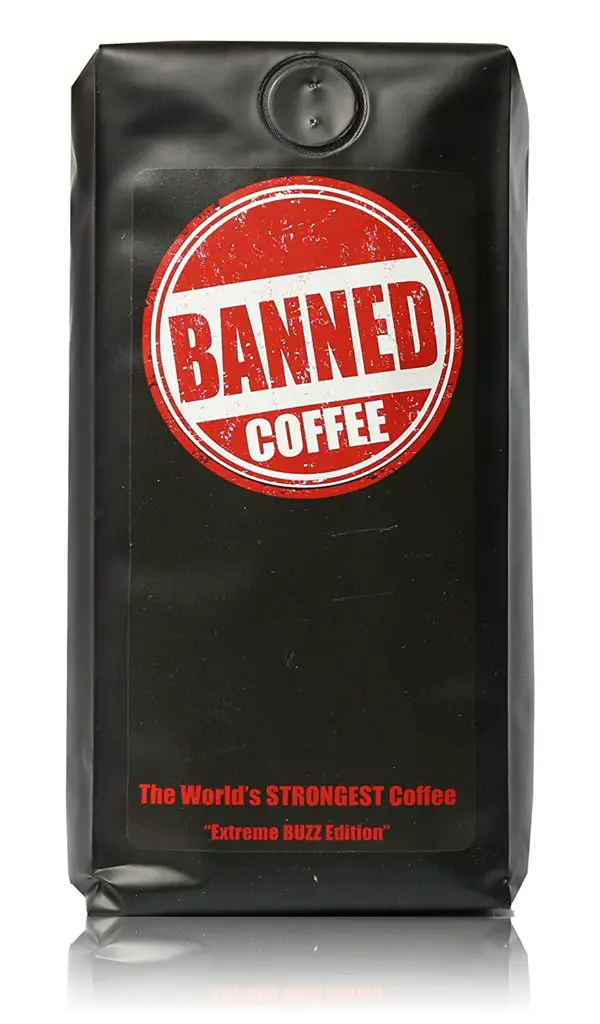
– Banned Coffee
It claims to be stronger than heavy hitters like Death Wish. With a medium-dark roasted blend of Arabica and Robusta, it gives you a rich brew with heavenly chocolate and berry notes. Using just 2.5 tablespoons to 6 fluid ounces of water puts 237 mg of caffeine into your 6-ounce cup. For comparison, the same size for Death Wish gives you 151 mg.

– Shock Coffee
Shock Coffee is considered the first in the whole super-caffeine realm. Their coffee puts out around 50% more caffeine than regular gourmet coffee brands. It won’t send your pulse racing but it will give you just enough extra boost and plenty of good, rich flavor with chocolate notes.
What’s the effect of caffeine on your body?
Caffeine works by altering the actions of some of your hormones and neurotransmitters in the body. The caffeine starts off by binding itself to your adenosine receptors in your brain and nervous system. The receptors suppress the activity levels of the neurons that they interact with.
Adenosine has long been associated with promoting sleep and relaxation while squelching arousal. So, since caffeine binds to these receptors, it keeps them from doing their job. In other words, caffeine is that party animal roommate you had in college that wants to keep on going all night.
After caffeine has worked its magic to suppress that function, there begins a cascading effect in the body. This effect alters the functioning of your other hormones and neurotransmitters. Perhaps most significantly is how it affects your adrenals and their secretion of epinephrine and cortisol. If those sound familiar, you probably recall them from science class somewhere down the line. These are those flight or fight hormones that speed up your heart and respiration while telling your smooth muscles to relax.
Caffeine can increase the epinephrine in your body by up to 250%. In essence, it stimulates you by creating that stress response. Interestingly though, it also boosts the circulation of serotonin in your nervous system. Yup, that’s the feel-good chemical and it’s exactly why you feel so darned good when you drink your cup of caffeine all the while feeling more energetic. Hooray for caffeine!
So, what’s the verdict? Is caffeine good for you?
Over the years, there were reports that coffee was bad for you. Then it was good. Then bad. And now it’s good. And it seems that’s the way it’s staying. Drinking 3 cups of coffee every day has been shown to be good for you. Yay!
There’s a study that found that 3 cups of coffee a day may make you live longer. They found that those who drank it regularly were 17% less likely to die young than those that didn’t drink coffee. Heart death risk also fell by one fifth while Alzheimer’s risk fell by a quarter. Liver disease risks fell by over one third.
What’s more, those who drink coffee regularly were found to be 18% less likely to get cancer than occasional coffee drinkers. It provided the best protection for the liver and bowels too. Drinking a lot of coffee cut the risk of gout in half and type 2 diabetes, which continues to soar, was reduced by a third.
So, yeah, go ahead and grab another cup of coffee. But do be mindful of that caffeine. Read on!
But how much caffeine is too much?
According to the Dietary Guidelines for Americans for the years 2015 to 2020, it states that adults shouldn’t consume over 400 mg of caffeine each day. Kids shouldn’t have caffeine (children and adolescents) according to the American Academy of Pediatrics, notes the FDA. But a review from 2017 suggests that those aged 12 to 18 years should have less than 100 mg of caffeine per day.
If the thought of serving coffee to kids sounds disturbing, just remember caffeine comes in sodas. And if you let your teens have some decaf, they’re still getting caffeine. Just not that much (unless they go to Dunkin that is!). For children under the age of 12, caffeine can take on a stronger effect since they weigh less. They can tolerate 2.5 mg of caffeine on average per every one kilogram of their body weight.
Side effects of caffeine
One thing you should know about caffeine is that it can mask the feeling that your body needs more rest. It’s important to listen to your body and take the time you need to get rest and recover.
As a diuretic, caffeine makes you urinate more often. If you find you can’t hold it and keep getting up to pee, you should probably choose a coffee with less caffeine in it. Ditto for the bowels. That morning cup of coffee can sure get things moving. And while that’s a good thing, it might not be the most convenient time to go. No one wants to be THAT person at the office.
For those active in sports and competitions, caffeine can cause diarrhea if your bowel movements are already loose. Others may have an upset stomach or indigestion with the consumption of too much caffeine. It might take a little experimentation to see how much is a good amount for you.
Additionally, if you’re the nervous type, caffeine might not be a good idea. It can cause your muscles to shake and break your concentration.
How caffeine affects a person’s ability to do sports
Caffeine is also found in a lot of supplements for exercise. For some people, this can boost energy and make you exercise harder and longer. For others, it might cause the jitters and have the opposite effect.
In studies, it was found that 200 to 350 mg of caffeine was helpful for endurance. It is surmised that the caffeine caused the body to use fat for fuel rather than stored sugar. Caffeine might also affect the brain so that athletes aren’t aware of being tired. Therefore, with moderate consumption of caffeine, it could give you the mental boost you need to compete at your best. And since it elevates mood, it might just inspire you to work out more on the regular.
But if you’re using caffeine to help propel you to the next level in sports, you should know that high levels of caffeine (like 800 mg each day) are banned from institutions including the International Olympic Committee. Less than 350 mg is advised each day for competitions.
So, how can you “safely” enjoy caffeine?
We’re not doctors here, but the following is sound advice for enjoying caffeine safely. If you take certain medications or have certain conditions, you should talk to your doctor to find out if you can have caffeine and what any side effects might be.
– Don’t drink it every day
Yes, this one is a tough one to swallow since starting the day off with coffee is how most of us function. You should try to get a day in the week when you don’t drink coffee or caffeinated beverages. If that’s impossible, limit yourself to just one cup per day.
– Find your right dose
If you drink so much coffee that you have the jitters, you’ve gone overboard. If you feel nothing, you aren’t getting enough caffeine. It’s all a fine line to walk and each of us has a different tolerance inside the spectrum of safe caffeine milligrams to consume. It might just take some experimenting on your part. If you drink 2 cups of coffee and feel like you’re on top of the world but drink a third cup and start feeling jumpy, you’ll know that 2 cups is your best amount.
– Consult your doctor
As mentioned, we’re not doctors here on this site and we’re not aware of your medical history. That being said, if you’re concerned about how much caffeine you’re consuming, you should definitely discuss it with your doctor. But there are some things that are just plain common sense. For example, if you regularly polish off an entire pot or even 2 of coffee every day, it doesn’t take a medical degree to advise you to cut down on your consumption a bit.
Remember, there is such a thing as having too much of a good thing. Find the right level for you and stick to it!
My Favorite Caffeine Alternative
Would you like the effects of caffeine without getting jittery or getting up to pee every 5 minutes? Try cacao. It’s unprocessed chocolate and it has a compound that is in the same family as caffeine. Only this compound doesn’t touch your nervous system. It stimulates the blood flow through your body. With the circulatory system delivering more nutrients up to that brain of yours, cacao allows you to feel more alert and energetic without adverse side effects.
It’s certainly something to try on those days you want to take a break from caffeine!
Conclusion
As you’ve just read, there are many factors that go into computing how much caffeine is in your cup of coffee. From the beans to the brewing method to the cup size to the water temperature, these can all change up how much caffeine you’re getting.
If you feel jittery, it’s never a good thing. You should cut down a bit on your caffeine consumption. However, if you feel great then you know you’re at the right level. Don’t tempt fate by drinking more of it than you should. Everything has its limits and caffeine can make you feel rather unpleasant if you have too much. Balance is always key when having your coffee so choose good quality and it will make you less likely to go overboard when every little sip is so satisfying.
